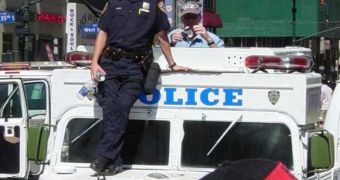Each Group of 20 (G20) meeting attracts numerous anti-globalization protesters, and authorities have a hard time keeping things under control. Violent clashes occur very often, and the police have been forced to deploy new weapons to the urban battlefield, in addition to the usual water cannons and rubber bullets. As the current G20 meeting takes place in Pittsburgh, the United States, authorities have for the first time used a Long-Range Acoustic Device (LRAD), commonly known as a sound weapon, or sonic cannon, on the population, LiveScience reports.
“There was an array of sound amplifiers used during the demonstration. The Poconos police brought the long-range acoustic device with them, but I don't know whether it was used,” said Pittsburgh Bureau of Police representative Lavonnie Bickerstaff. The LRAD is essentially designed for long-range communication, say experts from the American Technology Corporation (ATC), which developed the weapon. Its goals is to deliver an “unmistakable warning” over long distances, in a way that cannot be ignored. Unlike conventional systems used at protests, the LRAD can be heard clearly and intelligibly even hundreds of feet away, at the back of the crowd.
“The LRAD basically is the ability to communicate clearly from 300 meters to 3 kilometers (nearly 2 miles). It's a focused output. What distinguishes it from other communications tools out there is its ability to be heard clearly and intelligibly at a distance, unlike bullhorns,” says ATC media and investor relations official Robert Putnam. According to its specifications, the instrument has the ability to make itself heard over 1,600 feet (500 meters) away from its location. It can produce a tone intensity of between 145 and 151 decibels, which is the equivalent of a gunshot detonating right next to your ear.
According to the US National Institutes of Health (NIH), most people experience pain in their ears at sounds that exceed 120 decibels. At 150, everyone has adverse reactions to the sounds. The agency also warns that exposure to such intense sound waves can produce irreparable damage to the ear, most noticeably in the tiny hair cells that convert air wave variations into electrical impulses, which are then sent to the brain for processing. “Once damaged, our hair cells cannot grow back,” the NIH states.
Putnam says that the LRAD is not harmful in the way NOH describes it. “There's no way it can hurt you unless you have the ability to stand in front of it closely for several minutes,” he says. “It's like having a rock concert in three hours given to you in a half-hour,” the representative adds. According to Gizmag, the instrument produces “painfully loud sound frequencies that are concentrated in a narrow beam and easily direct them at a target, not unlike using a spotlight.”

 14 DAY TRIAL //
14 DAY TRIAL //